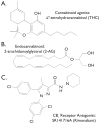Pursuing paradoxical proconvulsant prophylaxis for epileptogenesis
- PMID: 19552655
- PMCID: PMC2894282
- DOI: 10.1111/j.1528-1167.2009.02173.x
Pursuing paradoxical proconvulsant prophylaxis for epileptogenesis
Abstract
There are essentially two potential treatment options for any acquired disorder: symptomatic or prophylactic. For acquired epilepsies that follow a variety of different brain insults, there remains a complete lack of prophylactic treatment options, whereas at the same time these epilepsies are notoriously resistant, once they have emerged, to symptomatic treatments with antiepileptic drugs. The development of prophylactic strategies is logistically challenging, both for basic researchers and clinicians. Nevertheless, cannabinoid-targeting drugs provide a very interesting example of a system within the central nervous system (CNS) that can have very different acute and long-term effects on hyperexcitability and seizures. In this review, we outline research on cannabinoids suggesting that although cannabinoid antagonists are acutely proconvulsant, they may have beneficial effects on long-term hyperexcitability following brain insults of multiple etiologies, making them promising candidates for further investigation as prophylactics against acquired epilepsy. We then discuss some of the implications of this finding on future attempts at prophylactic treatments, specifically, the very short window within which prevention may be possible, the possibility that traditional anticonvulsants may interfere with prophylactic strategies, and the importance of moving beyond anticonvulsants-even to proconvulsants-to find the ideal preventative strategy for acquired epilepsy.
Figures




Similar articles
-
Therapeutic effects of cannabinoids in animal models of seizures, epilepsy, epileptogenesis, and epilepsy-related neuroprotection.Epilepsy Behav. 2017 May;70(Pt B):319-327. doi: 10.1016/j.yebeh.2016.11.006. Epub 2017 Feb 9. Epilepsy Behav. 2017. PMID: 28190698 Free PMC article. Review.
-
Cannabinoids as potential anti-epileptic drugs.Curr Opin Investig Drugs. 2005 Jul;6(7):680-5. Curr Opin Investig Drugs. 2005. PMID: 16044663 Review.
-
Do proconvulsants modify or halt epileptogenesis? Pentylenetetrazole is ineffective in two rat models of temporal lobe epilepsy.Eur J Neurosci. 2012 Aug;36(4):2505-20. doi: 10.1111/j.1460-9568.2012.08143.x. Epub 2012 Jun 5. Eur J Neurosci. 2012. PMID: 22672239
-
Cannabidiol: pharmacology and potential therapeutic role in epilepsy and other neuropsychiatric disorders.Epilepsia. 2014 Jun;55(6):791-802. doi: 10.1111/epi.12631. Epub 2014 May 22. Epilepsia. 2014. PMID: 24854329 Free PMC article. Review.
-
Prevention or modification of epileptogenesis after brain insults: experimental approaches and translational research.Pharmacol Rev. 2010 Dec;62(4):668-700. doi: 10.1124/pr.110.003046. Pharmacol Rev. 2010. PMID: 21079040 Free PMC article. Review.
Cited by
-
Searching for the ideal antiepileptogenic agent in experimental models: single treatment versus combinatorial treatment strategies.Neurotherapeutics. 2014 Apr;11(2):373-84. doi: 10.1007/s13311-013-0250-1. Neurotherapeutics. 2014. PMID: 24425186 Free PMC article. Review.
-
Selective reduction of cholecystokinin-positive basket cell innervation in a model of temporal lobe epilepsy.J Neurosci. 2010 Jun 30;30(26):8993-9006. doi: 10.1523/JNEUROSCI.1183-10.2010. J Neurosci. 2010. PMID: 20592220 Free PMC article.
-
Marijuana, endocannabinoids, and epilepsy: potential and challenges for improved therapeutic intervention.Exp Neurol. 2013 Jun;244:43-50. doi: 10.1016/j.expneurol.2011.11.047. Epub 2011 Dec 9. Exp Neurol. 2013. PMID: 22178327 Free PMC article. Review.
-
Integrating endocannabinoid signaling, CCK interneurons, and hippocampal circuit dynamics in behaving animals.Neuron. 2025 Jun 18;113(12):1862-1885. doi: 10.1016/j.neuron.2025.03.016. Epub 2025 Apr 22. Neuron. 2025. PMID: 40267911 Free PMC article. Review.
-
Disease-modifying effects of phenobarbital and the NKCC1 inhibitor bumetanide in the pilocarpine model of temporal lobe epilepsy.J Neurosci. 2010 Jun 23;30(25):8602-12. doi: 10.1523/JNEUROSCI.0633-10.2010. J Neurosci. 2010. PMID: 20573906 Free PMC article.
References
-
- Annegers JF, Rocca WA, Hauser WA. Causes of epilepsy: contributions of the Rochester epidemiology project. Mayo Clin Proc. 1996;71:570–5. - PubMed
-
- Arnone M, Maruani J, Chaperon F, Thiebot MH, Poncelet M, Soubrie P, Le Fur G. Selective inhibition of sucrose and ethanol intake by SR 141716, an antagonist of central cannabinoid (CB1) receptors. Psychopharmacology (Berl) 1997;132:104–6. - PubMed

